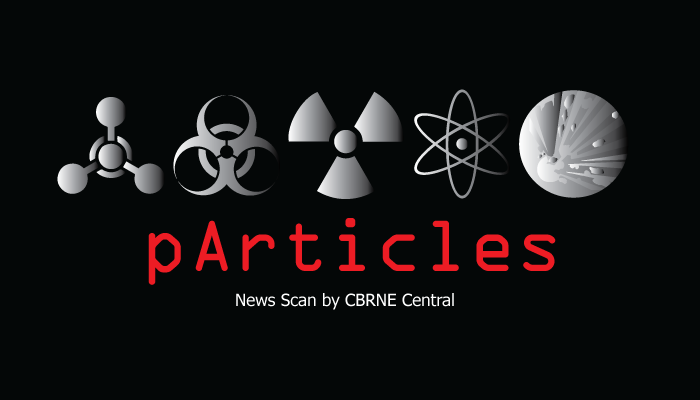Topics in this issue include evolving CBRN threats, 20th anniversary of the Comprehensive Nuclear Test Ban Treaty, ultra-trace detection of chemicals, and cyber attacks of critical infrastructure.
In This Article
20 Years Later, the CTBT Is Still in Limbo
It’s been 20 years since the Comprehensive Nuclear-Test-Ban Treaty (CTBT) was adopted by the United Nations General Assembly in 1996, but it has yet to enter into force because eight states have been unable to ratify it. Each of these states has had reservations over the CTBT and the global non-proliferation regime, where the treaty has either been viewed as discriminatory or untenable given the security environment that countries find themselves in. The Diplomat >>
Emergent Passes Inspection of Anthrax Vaccine Manufacturing Facility
Emergent BioSolutions Inc. announced on June 21 that the U.S. Food and Drug Administration (FDA) has completed its Pre-Approval Inspection (PAI) of Building 55, the company’s facility for large-scale manufacturing of BioThrax (Anthrax Vaccine Adsorbed). Global Biodefense >>
Japan Could Go Nuclear ‘Virtually Overnight’ Joe Biden Tells Chinese President
Biden made his disclosure while giving a speech at a Public Broadcasting Service program aired on Monday. Biden said he had urged Xi to exert influence on North Korea so it will abandon its missile and nuclear weapons developments. Forbes >>
California Might Close Its Last Nuclear Plant
California’s biggest electric utility announced a plan on Tuesday to shut down the state’s last remaining nuclear power plant within the next decade. The plant, Diablo Canyon, has been controversial for decades and resurfaced in the news over the last few months as Pacific Gas & Electric approached a deadline to renew, or not, the plant’s operating license. City Lab >>
An Improved and Scalable Synthesis of an Insensitive High Explosive
4,10-Dinitro-2,6,8,12-tetraoxa-4,10-diazaisowurtzitane (TEX), a well-known nitramine category explosive, is much less sensitive to impact and friction stimuli as compared to the familiar explosives, RDX and HMX. TEX is currently produced on pilot plant scale and is being pursued as an insensitive explosive. American Chemical Society >>
Right Dose for Accurate Diagnosis: Track Radiation Dose to Patients and Use Diagnostic Reference Levels
Evaluation of radiation dose levels during diagnostic radiological procedures, and the use of this data to improve quality of diagnostic exams and patient safety were among the topics discussed at a recent IAEA meeting on patient dose monitoring. According to the last available data, over 4 billion diagnostic radiological procedures are performed around the world. IAEA >>
Obama Set to Sign Bipartisan Update of 1976 Toxic Substance Law
President Obama is scheduled to sign into law the Frank R. Lautenberg Chemical Safety for the 21st Century Act, an update of toxic substance regulations originally championed by Mr. Lautenberg, the Democratic senator from New Jersey who died in 2013. The legislation is the first major rewrite of the toxic substance law since it was originally passed in 1976, and it is being hailed as a landmark improvement in protecting the public from dangerous substances. NY Times >>
New and Evolving CBRNe Threats Facing the
Post-9/11 Generation
In the early morning hours of June 12, 2016, America’s worst mass shooting occurred, reminding us once again that terrorism has evolved in a way that makes it increasingly difficult to prevent. While it is unclear how much the shooter’s actions were inspired by hate and bigotry and how much by an allegiance to the Islamic State terrorist organization, it is clear that American citizens are increasingly vulnerable to attacks. CBRNe Portal >>
How War Drives Terrorism
Study after study has found no common profile of a terrorist. It is hard to explain why, say, almost four times as many recruits leave Sweden to fight with the Islamic State as from neighboring Norway, though Sweden’s population is only twice Norway’s. Terrorist groups don’t emerge out of nowhere, and wars are perhaps the richest soil for seeding and growing violent groups of all stripes. Brookings >>
New Nuclear Weapon’s Costs
An Op-Ed published last week asserted that the Energy Department’s National Nuclear Security Administration has not revealed cost estimates for its portion of the Pentagon’s new nuclear weapon, the Long-Range Standoff Weapon: namely, extending the life of the W-80 warhead for the Air Force’s cruise missile. Every year, the agency delivers to Congress and the public a Stockpile Stewardship and Management Plan, providing a 25-year budget outlook. NY Times >>
Virtual Reality Comes to US Military’s Mapping Agency
U.S. officials abroad may soon be able to use their smartphone cameras to help swiftly reconstruct a bomb scene for eyes wrapped in Oculus 3-D headgear back in Washington. One day, a Foreign Service officer in Somalia might be able to use his smartphone camera to help swiftly reconstruct war devastation for eyes wrapped in Oculus 3-D headgear back in Washington. Defense One >>
Top Scientists Call for Obama to Take Nuclear Missiles Off Hair-Trigger Alert
More than 90 prominent US scientists, including 20 Nobel laureates and 90 National Academy of Sciences members, sent a letter to President Obama yesterday urging him to take US land-based nuclear missiles off hair-trigger alert and remove launch-on-warning options from US warplans. Union of Concerned Scientists >>
We Already Have an Arsenal Plane: It’s Called the B-52
In 1979, the Carter administration proposed a converted Boeing 747-200 as the Cruise Missile Carrier Aircraft, loaded with 72 nuclear-tipped air-launched cruise missiles. The concept briefings for the miniature air-launched decoy (MALD) are littered with images showing the MALD being dispensed from a C-130 or C-17. The concept of the “missile caddy,” which was intended to increase the number of air-to-air missiles available to a fighter, has been around at least since the 1990s. War on the Rocks >>
North Korea’s Successful Missile Test Shows Program’s Progress, Analysts Say
A day after North Korea launched an intermediate-range ballistic missile into high altitude — after five consecutive launch failures — the country’s state-run media proclaimed the test a success on Thursday, and quoted Kim Jong-un, North Korea’s leader, as boasting that his arsenal could strike United States forces in the Pacific. NY Times >>
How Obama Could Revolutionize Nuclear Weapons Strategy Before He Goes
During the past half century, no president has dared to change the nation’s nuclear strategy in any fundamental way. Mired in a Cold-War mind-set, the strategy today has grown less and less connected to the contemporary world and its emerging security threats: terrorism, proliferation, cyber warfare, economic disruption, mass refugee migrations and climate change. Though the strategy’s underlying principles are increasingly outdated, they still underlie a raft of crucial defense policies and programs. Politico >>
US Military Can’t Train to Fend Off the Worst Cyber Attacks on Infrastructure — Yet
Last Friday, Cyber Command wrapped up Cyber Guard, a major exercise that gathered 800 representatives from DOD, DHS, FBI, and industry to practice repelling a major network attack on U.S. infrastructure. The exercise took place on a joint information operation range in Suffolk, Va. — a kind of cyber firing range. The exercise, however didn’t fully emulate the full range of tactics and techniques that hackers might deploy against U.S. infrastructure. NextGov >>
Ultratrace Detection of Toxic Chemicals
Chemical sensors offer opportunities for improving personal security, safety, and health. To enable broad adoption of chemical sensors requires performance and cost advantages that are best realized from innovations in the design of the sensing (transduction) materials. Ideal materials are sensitive and selective to specific chemicals or chemical classes and provide a signal that is readily interfaced with portable electronic devices. PubMed >>


